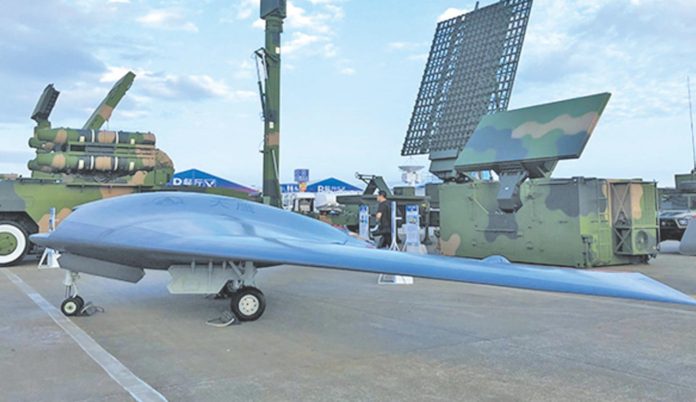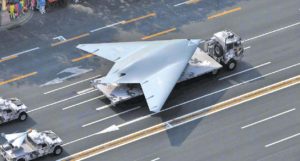Manned and Unmanned Teaming (MUM-T) combines the best of manned and unmanned platforms and produces a cumulative lethal power that is far beyond the sum of the parts. MUM-T is already beginning to take shape in China and Pakistan.
MUM-T operations provide diverse and varied uses and advantages. Some of them are:
- Enhancing situational awareness of the manned platform by increasing the number of sensors looking into the target volume of space or providing inputs from the airspace not visible to the manned platform but from where threats can emanate suddenly.
- Placing a variety of arsenal in the hands of the pilot, far beyond the capacity of his platform (guided missiles, rockets, guided bombs, anti-radiation missiles and more).
- Scout, early warning or dead zone look out role.
- Taking on the targets synched to the pilot’s sight in real time.
- Searching and selecting the targets and taking them on, based on pre-fed instructions.
- On authorization from the manned platform taking on a ‘repeat hit’ on the designated targets/auto re-firing (pro-active firing on its own) on targets perceived to be a miss on first strike.
- On instructions, leaving the MUM-T mission and branching off to take on a target located elsewhere(independent tasking, which can either be preplanned or impromptu).
MUM-T in China
China has a very strong and a high-end military drone force covering various ranges, altitudes, weapon carrying capabilities etc. Since most of its programmes have remained largely obscured from the public eye, full technical prowess of its machines is not really known to the extent desired. Most of it is assessed/inferred.
China has been working actively to develop drones that can not only communicate amongst themselves, but also, with the manned platforms in the MUM-T missions. The drones being developed will have one or both the capabilities, namely, surveillance or surveillance and combat. The Chinese developers are also actively building the ‘stealth muscle’ in their drones so that these remain undetectable by the adversary’s radar systems, also ensuring that there is enough usable space in these machines to load up substantial quantity of warheads.
One such Chinese drone – Sky Hawk also called the Tianying stealth combat drone – has the capability to communicate and collaborate with the fighter pilots in typical MUM-T missions.
During the National Day Parade held on 1 October 2019, China revealed a number of MUM-T enabled unmanned platforms that were under the veils of secrecy for years and not much was known of their developmental journey. One of them was Gongji-11 (GJ 11). This stealthy unmanned combat aerial vehicle (UCAV) is capable of undertaking autonomous missions deep inside enemy territory, or take part in MUM-T mode. Experts believe that GJ 11 (earlier referred to as Sharp Sword) is a most technologically impressive UCAV with a combat radius of over 1000 kms with 2×500 kg bombs or 8×100 kg bombs.
Another platform worthy of note was the WZ 8 supersonic reconnaissance vehicle. In a possible MUM-T mission with a strike force, such a machine will be able to keep pace with the force in time and space providing valuable and real time situational awareness.
China is known to possess the entire continuum of UAS both in reconnaissance, as well as, combat roles. For instance, in the category of Medium Range Long Endurance (MALE) drones category, (service ceiling up to 9000 metres, endurance up to 24 hours) it has three main types viz, BZK 005, GJ 1 and GJ 2. In the High Altitude Long Endurance (HALE) drones category (service ceiling 18000 metres, endurance 24 hours+), it has two main types – EA 03 and WZ 7.
Obviously with such a unmanned aerial system (UAS) arsenal at its command MUM-T will be very much a practiced concept with China, as will be the autonomous attacks using UAS, swarm attacks, etc.
India is likely to see Chinese MUM-T operations unfold in any future conflict. Short of conflict, the MUM-T role for reconnaissance and creating situational awareness data is highly likely.
Pakistan’s MUM-T Capability
Staring from its humble beginnings in 1997-98, Pakistan has built a significant base of UAS over the years. Most of its machines are for reconnaissance and surveillance roles. Some known names are Ababeel, Bazz, Uquab, Bravo, Bravo+, Mukhbar, Flemingo, Vector, Shadow, Vision, Nishan Mk II, Border Eagle and Hornet, etc.
Pakistan also holds small numbers of UAVs from several countries (ASN 105A and ASN 206 from China, Luna from Germany, Snipe Mk II and Streak from UK, Falco from Italy and Seeker from South Africa).
Pakistan tried for a long time to get UCAVs staring with the American Predator during the Global War on Terror (GWOT) from 2001 but never succeeded.
During 2009-2015, Pakistan tried to develop an indigenous UCAV called Burraq (range 1000 km, maximum speed 215 km/h, service ceiling 7500 meters). Burraq is claimed to be a state-of-the-art UCAV similar in capability to the US Predator or the Chinese Rainbow CH-3.
In October 2018, it was reported that Pakistan Aeronautical Complex and Chengdu Aircraft Corporation entered into a contract to co-produce 48 Wing Loong-II UCAVs for Pakistan. Wing Loong-II is a state-of-the-art export version of GJ-1 and GJ-2 drone capable of MUM-T role. It is suitable for surveillance and combat roles. It can carry a payload of 480 kg which may include a variety of munitions (FT7 130 kg bomb with planner wing, FT9 50 kg bomb, FT10 25 kg bomb, BRM 1 guided rocket, AKD10 missiles suitable for targets like bunkers, fortifications and vehicles or laser-guided air-to-surface missiles or YJ9E anti-ship missiles, etc.) It has a maximum speed of 370 kmph.
Overall, Pakistan’s reconnaissance and surveillance UAS are not generationally advanced to have MUM-T capabilities.
Live videos of Burraq’s first firing in September 2015 on a terrorist hideout in the Shawal Valley (where it reportedly killed 17 terrorists) and, later on, other terrorist hideouts in the Tirah Valley in the Khyber Pakhtunkhwa Province as a part of Operation Khyber, do indicate smooth flow of communication between the UCAV and its controllers
Whether this capability has been upgraded to adapt Burraq in a typical MUM-T mission is not known. Since it is likely, it would be wiser to accept that it has been done.
The Wing Loong-II is a top-end MUM-T player. There is no doubt that the MUM-T capability of Wing Loong will be fully exploited by Pakistan Air Force in any future conflict.
India’s MUM-T Capabilities
India started acquiring UAVs in 1997-98 with the acquisition of Searcher Mk1 UAS from Israel. This was followed by the addition of Searcher MkII and the Heron UAS.
These were first and second-generation machines suitable for traditional roles like surveillance, reconnaissance and intelligence gathering, target acquisition, target support, direction of fire, etc.
The Defence Research & Development Organisation (DRDO) also began development of a whole range of UAVs – Abhyas, Aura, Eagle, Kapothaka, Lakshya, Netra, Nishant, Panchi, Rustom, Ulka, Gagan and others. None of them are MUM-T capable.
On 25 June 2016, the Defence Acquisition Council cleared the procurement of 22 Sea Guardian surveillance drones for the Indian Navy for surveillance tasks in the Indian Ocean Region (IOR) from General Atomics. Sea Guardian is the naval version of the Predator drone. The number of Sea Guardians was later reduced from 22 to 12.
In February 2020, it was reported that India was looking for the MQ9 Predator B (Reaper) with Hellfire missiles. The plan is to purchase 30 drones, 10 each for the three Services.
Reaper drone with Hellfire missiles is the top-of-the-line UCAV. This is the same drone which killed Maj Gen Qasem Soleimani, commander of the Iranian Quds on 3 January 2020.
The MQ9 has a speed of 313 kmph, 1900 kms range with 4x Hellfire missiles (or bombs). MQ9 is a high-end MUM-T player.
A $3 bn deal signed was signed on 28 September 2015 for the purchase of 22 AH-64E Apache attack helicopters and 15 Chinook heavy-lift helicopters from Boeing. 17 Apaches have since been delivered while the remainder 5 will arrive by end-March 2020. During US President Donald Trump’s visit to India on 25 February 2020 another deal was signed for an additional six Apache helicopters for the Indian Army. Hellfire missiles are the basic weapons with Apaches.
Apache is a tested platform for the MUM-T role. The MUM-T combination of Apache 64 E paired with MQ1-C Grey Eagle unmanned aircraft has already been tried out and tested by the US Army.
The crew of Apache 64E can control the sensors and the flight path of RQ7 Shadow and MQ1-C Grey Eagle drones – something which had not been tried earlier.
With Apaches already in the IAF inventory and the MQ9 Reaper drones in the pipeline, India will be surely move towards MUM-T capability.
The new platforms will have to knitted into common data links after addressing hundreds of compatibility and connectivity issues. Since MUM-T paired has been achieved with the MQ1-C and Grey Eagle drones, teaming the Apaches with MQ9 Reapers should be possible.
For effective MUM-T concepts have to be evolved. Network-centric communications riding on the current lifeline of BMC2 structures ( built on Air Force net or AF Net) have to be developed as common data links, critical skill-sets have to be identified and crews have to be trained, both in the manned, as well as, unmanned domain. In addition, specific battle drills have to be perfected.
==============
China’s Sky Hawk stealth drone has capability to ‘talk’ to fighter pilots, according to developers
China unveiled its stealth attack drone, Gongji-11 (GJ-11), at the National Day parade, on 1 October 2019, indicating it is in active Chinese military service


















